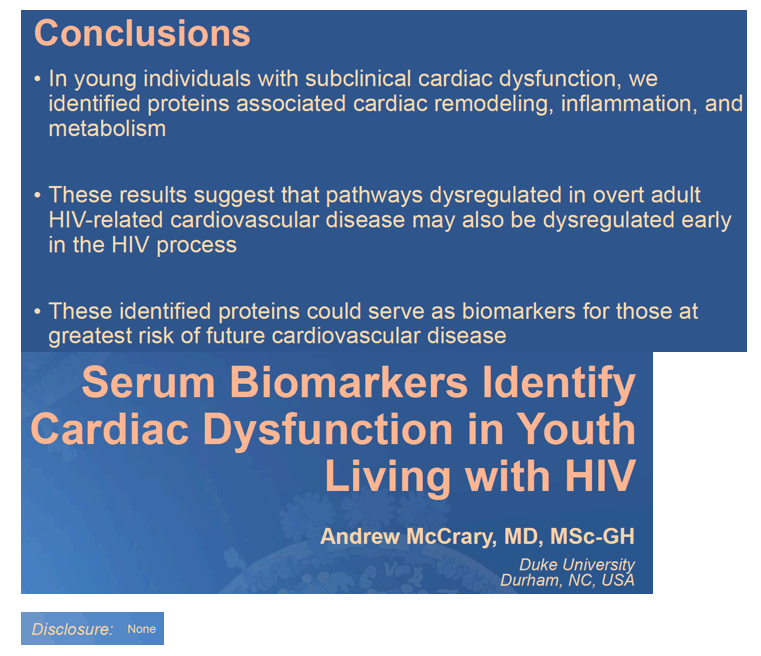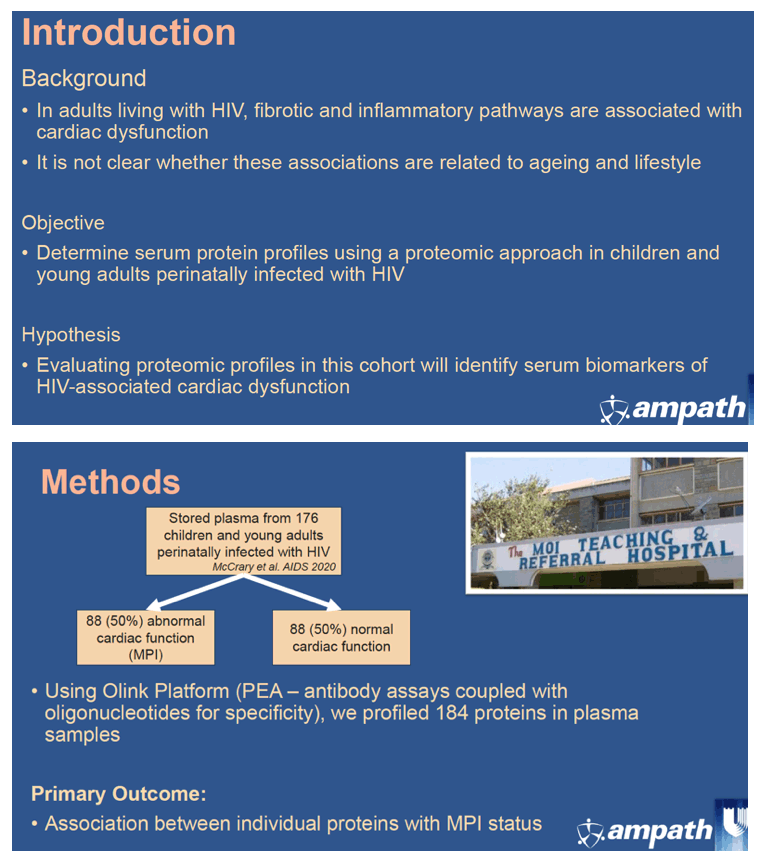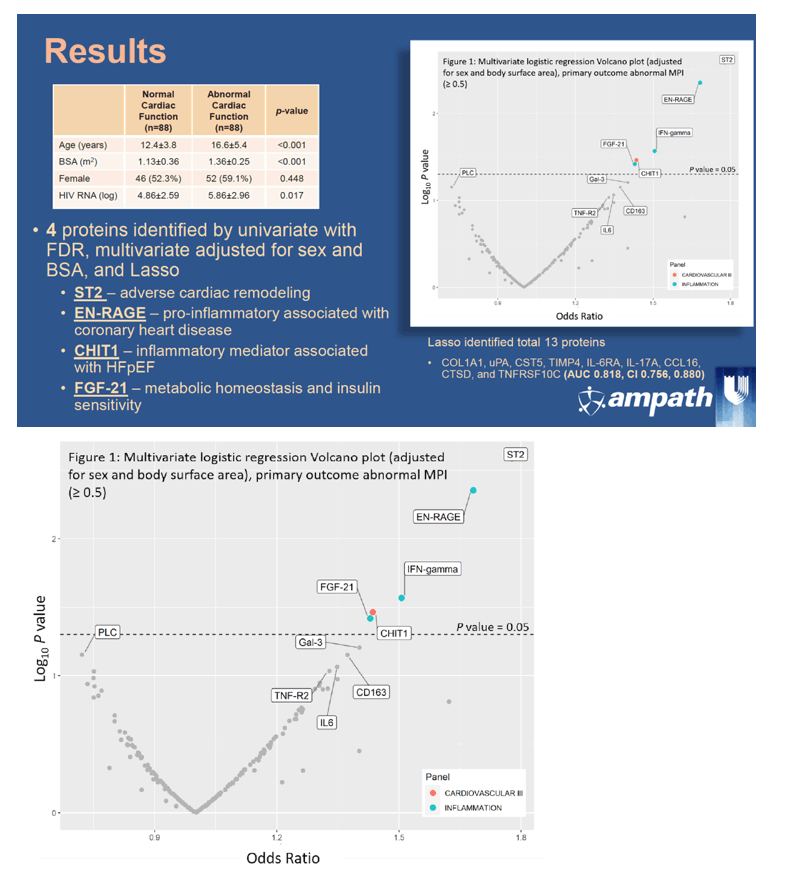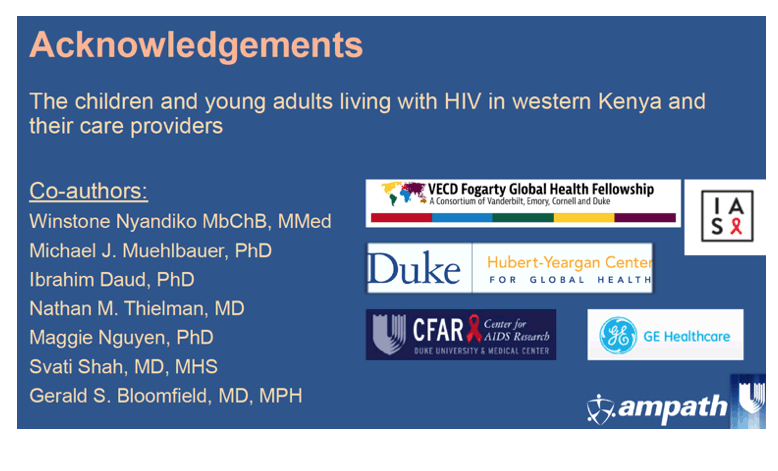| |
SERUM BIOMARKERS IDENTIFY CARDIAC DYSFUNCTION IN YOUTH LIVING WITH HIV
|
| |
| |
CROI: BIOLOGICAL PROFILES PREDICT CORONARY ARTERY DISEASE IN PWH AND RISK-MATCHED CONTROLS - (03/08/21)
CROI: IDENTIFICATION OF UNIQUE PROTEINS PREDICTIVE OF MORTALITY AND MECHANISMS IN HIV - (03/08/21)
CROI: PREVENTION OF CARDIOVASCULAR DISEASE IN PERSONS WITH AND WITHOUT HIV - (03/08/21) High risk profile in PLWH
CROI 2021 March 6-10 Reported by Jules Levin
Andrew McCrary1, Winstone Nyandiko2, Michael J. Muehlbauer1, Ibrahim Daud3, Nathan M. Thielman1, Maggie Nguyen1, Svati J. Shah1, Gerald S. Bloomfield1 1Duke University, Durham, NC, USA, 2Moi University, Eldoret, Kenya, 3Walter Reed Project–Kericho, Kericho, Kenya
Background: In adults with HIV, fibrotic and inflammatory pathways are associated with cardiac dysfunction. It is not clear whether these associations are related to aging and lifestyle. We hypothesized that evaluating proteins in youth perinatally infected with HIV would help clarify this question, as well as identify biomarkers of cardiac dysfunction.
Methods: A total of 176 children and young adults perinatally infected with HIV selected from a previous study at Moi Teaching and Referral Hospital, Eldoret, Kenya, of which 88 (50%) had abnormal tissue Doppler derived myocardial performance index (MPI - global measure of left ventricular systolic and diastolic function) and 88 had normal MPI. Using the Olink platform (PEA - antibody assays coupled with an oligonucleotide for specificity), we profiled 184 proteins in plasma samples. Univariate logistic regression was used to determine association between individual proteins with MPI status (False Discovery Rate adjusted for multiple comparisons) and multivariable models adjusted for sex and body surface area were constructed for significant proteins. A Lasso regression was also used to construct a model most discriminate of abnormal MPI.
Results: The median age of the study population was 14.3 years (IQR 8.1). In the univariate model, 18 proteins were significantly associated with MPI status after FDR adjustment. Of these, 5 remained significant in multivariable models: ST2 (adverse cardiac remodeling, OR 1.8 CI 1.2, 2.6), EN-RAGE (pro-inflammatory associated with coronary heart disease, OR 1.7 CI 1.2, 2.4), CHIT1 (inflammatory mediator associated with heart failure with preserved ejection fraction OR 1.4 CI 1.0, 2.0), and FGF-21 (metabolic homeostasis and insulin sensitivity, OR 1.5 CI 1.0, 2.0) (Figure 1). In an orthogonal approach, the Lasso regression also identified these four primary proteins as well as COL1A1, uPA, CST5, TIMP4, IL-6RA, IL-17A, CCL16, CTSD, and TNFRSF10C (AUC 0.818, CI 0.756, 0.880).
Conclusion: Using proteomics profiling in a unique cohort of children and young adults perinatally infected with HIV from Kenya, we identified proteins reporting on cardiac remodeling, inflammation and metabolism with higher circulating levels in young individuals with subclinical cardiac dysfunction. These results suggest that pathways dysregulated in overt adult HIV-related cardiovascular disease may also be dysregulated early in the HIV process and thus could serve as biomarkers for those at greatest risk of future cardiovascular disease.




|
|
| |
| |
|
|
|